Maggie Plummer's Blog, page 2
January 26, 2013
Another chapter in the promotion machine
Another free-ebook promotion today and two more days after today...the last one, I am sure.
I want to say a big THANK YOU to the many people who run free-of-charge ebook websites that list FOR FREE the promotions. What a huge help! Among them is this one:
www.fkbooksandtips.com
Thanks, all of you!
I want to say a big THANK YOU to the many people who run free-of-charge ebook websites that list FOR FREE the promotions. What a huge help! Among them is this one:
www.fkbooksandtips.com
Thanks, all of you!
Published on January 26, 2013 16:15
December 12, 2012
Great Historicals: Spirited Away by Maggie Plummer
it's wonderfully gratifying to have this thoughtful review on a neat blog:
Great Historicals: Spirited Away by Maggie Plummer: It's May 1653. When young Frederica (Freddy) O'Brennan and her sister Aileen trust a stranger on an empty beach in western Ireland, they...
Great Historicals: Spirited Away by Maggie Plummer: It's May 1653. When young Frederica (Freddy) O'Brennan and her sister Aileen trust a stranger on an empty beach in western Ireland, they...
Published on December 12, 2012 11:43
December 2, 2012
A Golden Moment
Here's a little something I wrote a few years back. I hope you all will enjoy it.
Along a narrow road in southern Ireland’s County Tipperary sits the picturesque village of Golden, where an ancient stone bridge crosses the quietly flowing River Suir. Presiding over one end of the bridge is a crumbling, round castle tower. The old rock work on the bridge and the castle ruin is laced with lush ferns and ivy. During a recent trip across the Atlantic, I stumbled across this sweet little place and stopped to catch some photos. No one else was around on that warm September afternoon. Golden’s mysterious castle-tower-on-a-bridge was not a big tourist attraction, apparently. There were no direction signs or brochures or admission charges.
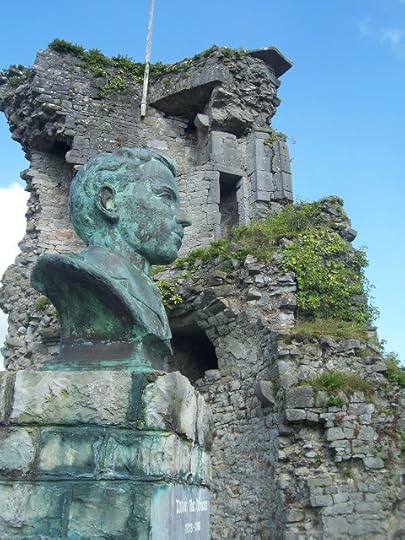
I walked around looking at the centuries-old circular tower and happened upon a commemorative statue and an aged, lichen-streaked, barely readable stone plaque. The hand-carved white letters were smudged and worn by years of wind and weather. Here is what it said: “Proudly remember Thomas MacDonaghTipperary Man,Commanded Jacob’s Garrison, Easter RisingDied like a Prince3rdMay 1916As you pass by, take heart from the nobility and sacrifice of men of differing racial origins who gallantly tended the flame of Irish freedom down the ages, in this countryside.Cherish not least our Norman forbears who raised this castle 700 golden years ago.” I read it again and photographed the plaque. I stood there and closed my eyes, touching the hand-carved letters. Somehow the sunny, peaceful afternoon had come to a standstill. “Easter Rising” was the first revolt in a series of battles that led to the successful Irish War of Independence. As I ran my fingers over those old stone-carved letters, it was as if Ireland’s passionate past reached right out of that rock and grabbed me by the neck, lifting the hair on my arms and raising more than a few goose bumps. Why did I react like that to a heartfelt, proud message on a plaque alongside a river in County Tipperary? Was it for the same reason that listening to bagpipes brings tears to my eyes? Or why my heart beats faster when I hear traditional Irish music? Growing up in an Irish Catholic household, I learned at my dad’s knee about the long, intense history of Catholic Ireland – the centuries of English oppression, injustice, and violence. I also learned about the 500-year-old, blood-stained struggle of indigenous Irish Catholics to take back control of their lands from the English, and to have their own free, self-governing Ireland. I found myself in tiny Golden because I’d decided to brave the narrow roads in my rented car and head to County Kilkenny, to gaze at the lands where my Irish Catholic Brennan ancestors once lived and farmed. My great grandfather, Michael Brennan, came to the United States in the 1870s. One of our vague family stories about why he left Ireland suggests that he and some of his brothers may have been involved with the Fenian Movement, a pro-Irish-Republic revolutionary organization. The story goes that my great grandfather may have been forced to leave Ireland to avoid punishment by the English. The swish and rumble of a truck going over the bridge brought me back to the present. Just downstream, a serene, grassy park with riverside benches was irresistible – a perfect place to sit and stare and memorize this place, this feeling, this slice of time. Near one of the benches I found another rock memorial with an even older-looking plaque, which read:“To the memory of Volunteer Patrick LynchKilled by known forcesOn the 20thNov. 1920Also his comrade Patrick O’Keeffe,Who was brutally beaten by the Black and TansAnd subsequently died of the injuries he received.
Erected by the Comrades of the 3rd Tipperary Brigade” The “Black and Tans,” a paramilitary force the English used at that time to suppress revolution in Ireland, were infamous for their frequent attacks on Irish civilians. During my two weeks in Ireland, I repeatedly fell in love with places like Golden – unsung and unexpected yet historically wealthy spots far off the beaten path. In farm fields, cows grazed in the shadow of archaic, broken down monasteries and castles. In the far west of the country, domestic sheep freely wandered among prehistoric tombs and the ruins of primordial dry-stone huts. Deep layers of unfathomable history are simply part of the Irish landscape. Golden, located in the famously fertile “Golden Vale of Tipperary,” was the site of violent land wars in the late 1800s. The village has a statue of that era’s Irish revolutionary leader, Charles J. Kickham, on its main street. The bridge and castle were built around 1179. Nearby is the legendary Jibbet's Cross, a tree where three men were hung in 1815 for the murder of a Justice of the Peace. Believe it or not, the men’s remains were left hanging under guard for two years. Below the cross there is now a memorial to two men shot during Ireland’s Civil War. The town swimming pool is named after a War of Independence veteran. Most of the folks in Golden are only two generations removed from relatives who fought in the War of Independence for a free Irish Republic. Their feelings are fierce, especially for their beloved Thomas MacDonagh, so eloquently honored by the statue and plaque on the bridge. I have since learned that he was an Irish nationalist, poet, playwright, editor, teacher, English professor at the National University of Ireland, and theatre director. He studied Irish heritage, loved the native Irish language, and was a member of the Gaelic League – an apolitical group that drew together Irish nationalists. One of Easter Rising's seven leaders, he was court-martialed for treason and executed by firing squadat the age of 38. Four days after he was killed, MacDonagh was written about in a New York Times article. Padraic Colum, an Irish poet and a friend of MacDonagh’s, was interviewed for the article and called the revolt “a poets’ revolution.” He commented that the rise of the Irish Republic was strangely literary in character, with writers and scholars leading the people to independence. According to Colum, “For the English people…all the Irish have the greatest liking…What we cannot endure is simply the English Government…simply the imposition upon us of a government from the outside with which we have no sympathy, and which has no sympathy with us.” The article included one of MacDonagh’s many poems, entitled “Of a Poet Captain:” “His songs were a little phraseOf eternal song.Drowned in the harping of laysMore loud and long.
His deed was a single word,Called out alone.In a night when no echo stirred to laughter,To laughter or moan.
But his songs new souls shall thrillThe loud harps dumb,And his deed the echoes fillWhen the dawn is come.” I wanted to linger on that bench beside the River Suir, in that sun-drenched, soulful village. But it was time to go. Tomorrow I’d be on a jet back to the States. As I reluctantly strolled back to the car, I knew it was a gift to have stopped here and been struck by this back road Golden moment.
Published on December 02, 2012 13:55
November 19, 2012
Great promotion!
Wow, what a great promotion! today's the last day of my novel's three-day Kindle e-book giveaway, and there have been about 27,000 Kindle editions downloaded!
Spirited Away: A Novel of the Stolen Irish is now #1 in Kindle's bestselling free historical fiction, and #1 Kindle free e-book. It hit #1 in both categories last night. I am just about jumping out of my skin here. (step away from the coffeemaker, hahaha)what else?Today the novel is also featured on this blog:
http://indieauthoranonymous.com/2012/...
how do I feel?
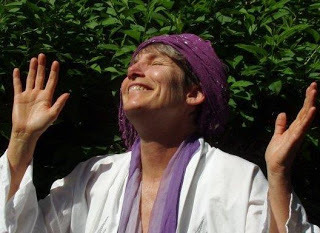
Spirited Away: A Novel of the Stolen Irish is now #1 in Kindle's bestselling free historical fiction, and #1 Kindle free e-book. It hit #1 in both categories last night. I am just about jumping out of my skin here. (step away from the coffeemaker, hahaha)what else?Today the novel is also featured on this blog:
http://indieauthoranonymous.com/2012/...
how do I feel?

Published on November 19, 2012 12:13
November 17, 2012
the answer: Dun Aengus!
The answer to my question:
Dun Aengus - The Fort of Aonghasa
an ancient stone fort atop a massive cliff on the Aran Island of Inishmore.
I'm so glad I took the trouble to go way out there and experience this place. As I walked to the fort, I wondered what the weird banging was. Turned out it was the Atlantic Ocean, pounding and ramming at the base of the cliff! If you ever get a chance to visit the place, be sure to do it. It's easy to imagine the Druids lighting huge bonfires at the edge of the cliff, some sort of signal that could be seen up and down a huge stretch of Ireland's west coast. But then again, where did they get the wood to burn? Or, what did they burn? This is one heck of a rough, rocky, barren island.
Plan ahead, then take your time. There are nice bed and breakfast places to stay, near the island's town of Kilronan.
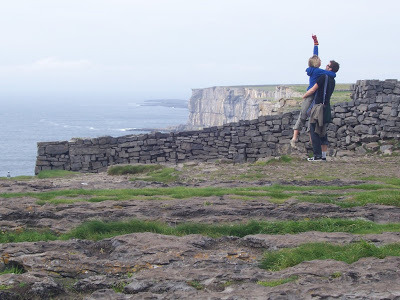
According to Wikipedia, Dún Aonghasa (anglicized Dun Aengus) is the most famous of several prehistoric forts on the Aran Islands of County Galway, Ireland...at the edge of an 100-metre-high cliff.
A popular tourist attraction, Dún Aonghasa is an important archaeological site that also offers a spectacular view. It is not known when Dún Aonghasa was built, though it is now thought to date from the Iron Age.
T. F. O'Rahilly surmised that it was built in the 2nd century BC by the Builg following the Laginian conquest of Connacht.
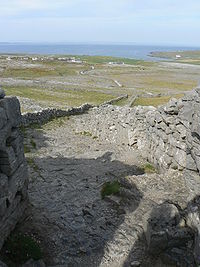
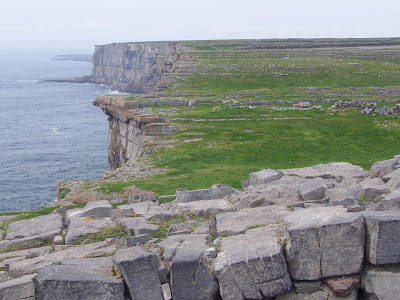
Dún Aonghasa is often called "the most magnificent barbaric monument in Europe." Its name, meaning "Fort of Aonghas", refers to the pre-Christian god of the same name described in Irish mythology, or the mythical king, Aonghus mac Úmhór.
According to the article on Trip Advisor:
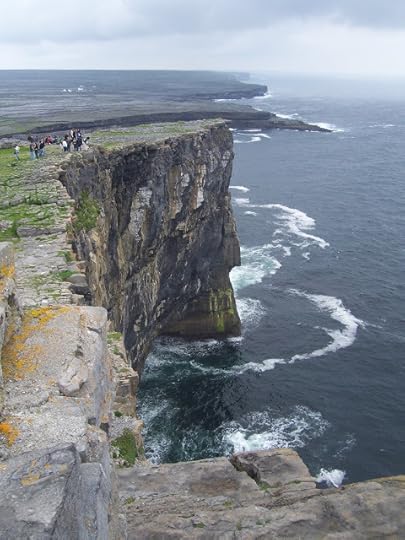
...to read what travelers think, go to http://www.tripadvisor.com/Travel-g55...
Dun Aengus - The Fort of Aonghasa
an ancient stone fort atop a massive cliff on the Aran Island of Inishmore.
I'm so glad I took the trouble to go way out there and experience this place. As I walked to the fort, I wondered what the weird banging was. Turned out it was the Atlantic Ocean, pounding and ramming at the base of the cliff! If you ever get a chance to visit the place, be sure to do it. It's easy to imagine the Druids lighting huge bonfires at the edge of the cliff, some sort of signal that could be seen up and down a huge stretch of Ireland's west coast. But then again, where did they get the wood to burn? Or, what did they burn? This is one heck of a rough, rocky, barren island.
Plan ahead, then take your time. There are nice bed and breakfast places to stay, near the island's town of Kilronan.

According to Wikipedia, Dún Aonghasa (anglicized Dun Aengus) is the most famous of several prehistoric forts on the Aran Islands of County Galway, Ireland...at the edge of an 100-metre-high cliff.
A popular tourist attraction, Dún Aonghasa is an important archaeological site that also offers a spectacular view. It is not known when Dún Aonghasa was built, though it is now thought to date from the Iron Age.
T. F. O'Rahilly surmised that it was built in the 2nd century BC by the Builg following the Laginian conquest of Connacht.


Dún Aonghasa is often called "the most magnificent barbaric monument in Europe." Its name, meaning "Fort of Aonghas", refers to the pre-Christian god of the same name described in Irish mythology, or the mythical king, Aonghus mac Úmhór.
According to the article on Trip Advisor:
"Dun Aengus is the most visited of the four stone forts on Inis Mor, it is located close to the village of Kilmurvey. The fort consists of three terraced walls, five metres high and four metres thick, surrounding an inner enclosure containing a platform on the edge of a one hundred metre high cliff. Surrounding the walls is a remarkable network of defensive stones known as a Chevaux de Frise. Archaeological reports suggest that the fort was once inhabited, though scholars have also suggested that as the platform faces out over the Atlantic it could have been used for ritual purposes. It is thought that parts of the cliff have collapsed into the sea.
"The views from Dun Aengus are absolutely spectacular. It is about a twenty minute walk from the small museum just off the main road. There isn't a proper footpath so care should be taken, especially when it's raining as it can become quite slippy. Be aware that there is no railing at the edge of the cliff so if you visit young children take extra care."In the photo below, find the tiny people...yep, there they are, right smack on the edge of the cliff...no railings, no fence. wow! (I'm chicken: I got down on my hands and knees to look over that edge...)

...to read what travelers think, go to http://www.tripadvisor.com/Travel-g55...
Published on November 17, 2012 14:11



